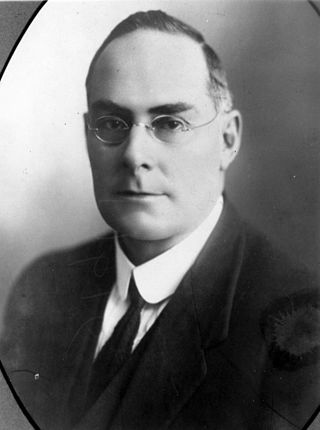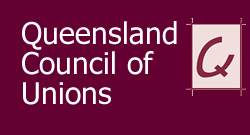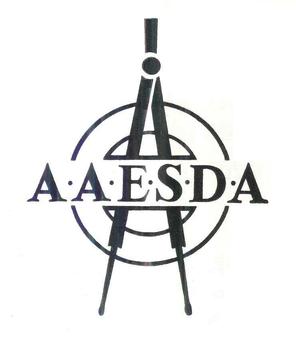
William McCormack was Premier of Queensland, Australia, from 1925 to 1929.
The Australian Workers' Union (AWU) is one of Australia's largest and oldest trade unions. It traces its origins to unions founded in the pastoral and mining industries in the late 1880s and it currently has approximately 80,000 members. It has exercised an outsized influence on the Australian Trade Union movement and on the Australian Labor Party throughout its history.
The Canadian Union of Postal Workers is a public-sector trade union representing postal workers including letter carriers, rural and suburban mail carriers, postal clerks, mail handlers and dispatchers, technicians, mechanics and electricians employed at Canada Post as well as private sector workers outside Canada Post. Currently comprising upwards of 50,000 members, the Canadian Union of Postal Workers has historically been labeled as militant because of some of the actions undertaken since its inception in 1965 to help guarantee rights to all postal workers. According to former president Jean-Claude Parrot, "We succeeded to get the support of the membership because we earned our credibility with them...we got that reputation [of militancy] because we earned it."

The Queensland Council of Unions (QCU) is a representative, an advocacy group, or peak body, of Queensland trade union organisations, also known as a labour council, in the Queensland, Australia. As of 2020, 26 unions and 13 regional branches were affiliated with the QCU. The QCU represents unions covering around 350,000 Queensland workers. It is affiliated with the Australian Council of Trade Unions (ACTU). Its offices are located in the suburb of South Brisbane, Queensland. As a peak body for the Queensland trade unions, the objective of the QCU is to achieve industrial, social and political justice for Queensland workers. The management structure of the QCU is made up of a committee of management and an executive of representatives comprised from affiliated unions.

The Australian Services Union is a trade union representing workers in a variety of industries.
The Seamen's Union of Australia (SUA) was the principal trade union for merchant seamen in Australia from 1876 to 1991. The SUA developed a reputation as one of the most militant trade unions in Australia and was closely associated with the communist movement in Australia. The SUA merged in 1993 with the Waterside Workers' Federation to become the Maritime Union of Australia (MUA).

The National Postal Mail Handlers Union (NPMHU) is a progressive labor union representing more than 50,000 Mail Handler craft members in United States Postal Service facilities across the United States.

The Communication Workers Union of Australia is a trade union in Australia. It is a division of the Communications, Electrical and Plumbing Union of Australia.

The Amalgamated Engineering Union (AEU) was a major British trade union. It merged with the Electrical, Electronic, Telecommunications and Plumbing Union to form the Amalgamated Engineering and Electrical Union in 1992.

The Electrical, Electronic, Telecommunications and Plumbing Union, known as the EETPU, was a British trade union formed in 1968 as a union for electricians and plumbers, which went through three mergers from 1992 to now be part of Unite the Union.

The Post Office Engineering Union (POEU) was a trade union in the United Kingdom. It represented engineering staff in the Post Office, mostly working in telecommunications.

The Civil and Public Services Association (CPSA) was a trade union in the United Kingdom, representing civil servants.
Manufacturing Grocers' Employees' Federation of Australia (M.G.U.) was an Australian trade union existing between 1906 and 1988. The union was first established as the Federated Candle, Soap, Soda & Starch Employees' Union of Australia, before changing its name in 1914. The union represented workers employed in manufacturing grocers' sundries and non-edible grocery products, particularly in the southern states of South Australia and Victoria. In 1988 the union amalgamated with the Federated Millers and Mill Employees' Union to form the Federated Millers and Manufacturing Grocers Employees' Association of Australia, which in turn merged with a number of unions to form the National Union of Workers.
Federated Liquor and Allied Industries Employees' Union of Australia (FLAIEU) was an Australian trade union which existed between 1910 and 1992. It represented workers employed in hospitality, catering, breweries and alcohol retailing.

The Association of Draughting Supervisory and Technical Employees (ADSTE), originally known as the Association of Architects, Engineers, Surveyors and Draughtsmen of Australia (AAESDA), was an Australian trade union which existed between 1915 and 1991. It represented white collar and technical-grade employees in both the private sector and the public service.
The Federated Moulders' (Metals) Union of Australia (FMMUA) was an Australian trade union which existed between 1899 and 1983. It represented moulders – skilled tradesmen who fabricated the moulds for casting metal products in foundries. In spite of only organising within a single skilled occupation, which kept total membership low, the vital position of moulders in major industries such as mining, manufacturing and the railways, ensured that the union remained industrially powerful with a reputation for being highly militant.
The Australian Telecommunications Employees' Association (ATEA) was an Australian trade union representing technical and trades employees in the telecommunications industry from 1912 to 1992. Its members were primarily employed by the Postmaster-General's Department, the Australian Broadcasting Control Board and the Department of Posts and Telecommunications.
The Australian Telephone and Phonogram Officers Association was an Australian trade union representing telephonists, phonogram operators and telex service operators in the Australian Public Service. It existed from 1914 to 1992.










